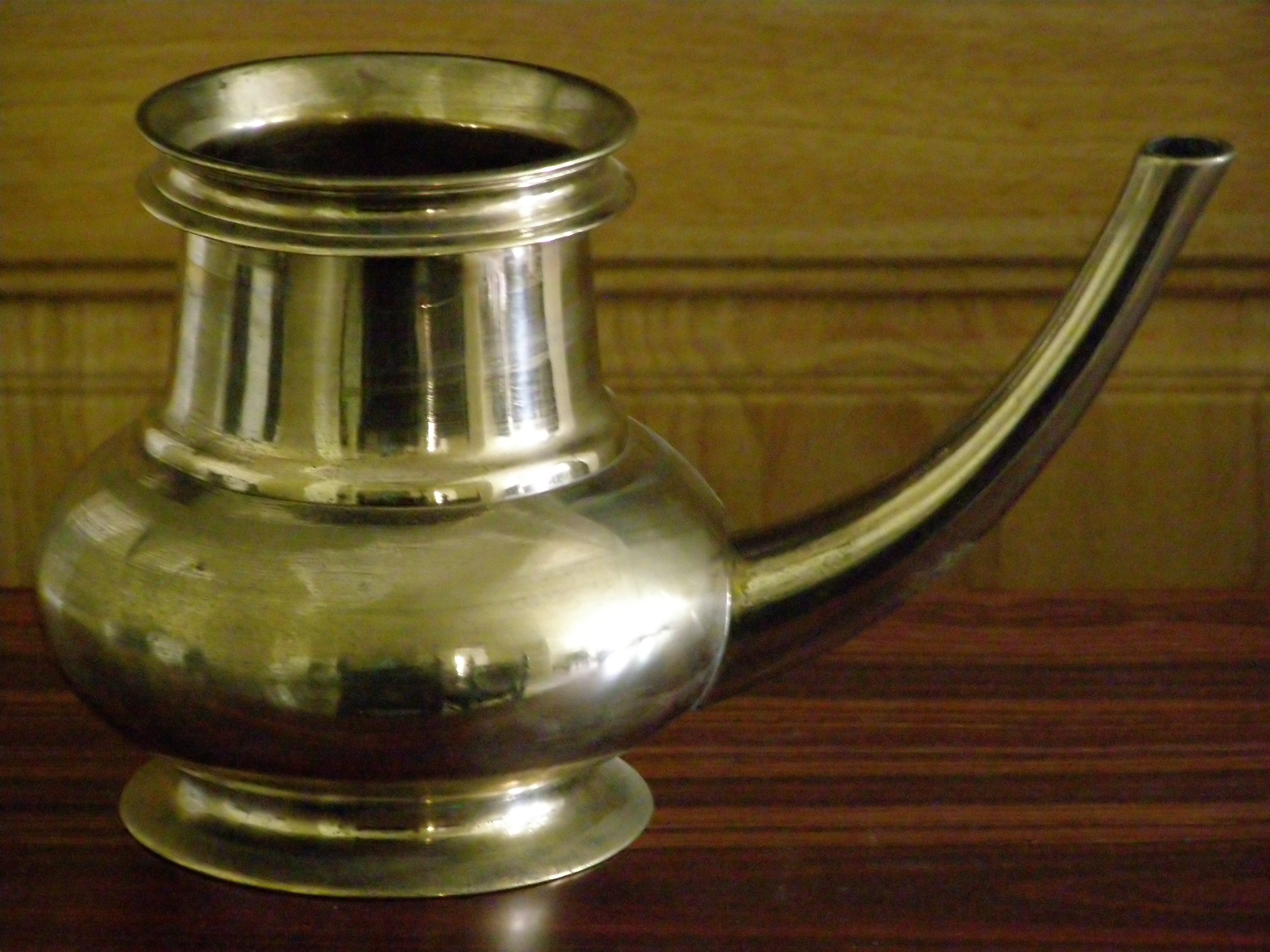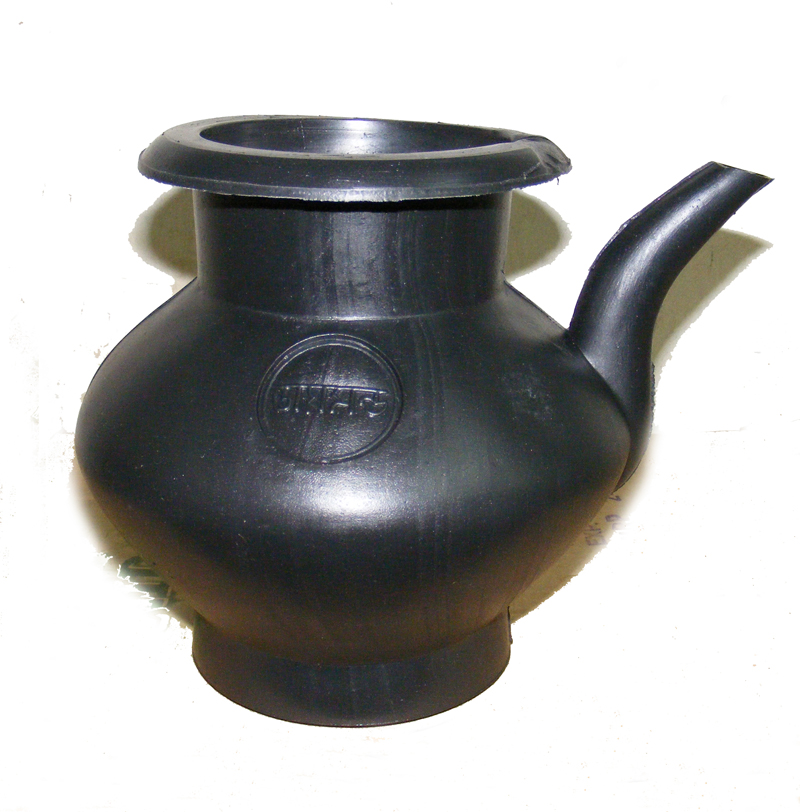|
Kindi (vessel)
Kindi is a type of a pitcher usually found in old houses in Kerala and other parts of India. Early examples of ''Kindi'' first appears in Chalcolithic period cultures of South Asia, notably in Daimabad#Phase_I:_Savalda_culture, Savalda Culture and two well-preserved examples from Daimabad#Phase_V:_Jorwe_culture, Jorwe culture pottery dating to 2nd millennium BC. Usually made of bell metal, it is commonly used during Puja (Hinduism), Puja to dispense Holy_water#Non-Christian_holy_water, holy water. Kindi is also used to keep water at the entrance of the house, so that visitors can wash their feet with this water, and also to wash hands after meals. The shape of Kindi is very effective to minimize water loss while washing the feet or hand, as it has only a small aperture to pour water. Its shape is also very attractive. While using Kindi, the hands of the user never touch the water inside the Kindi, so that water never get contaminated. See also * Lota (vessel) * Kalasha Referen ... [...More Info...] [...Related Items...] OR: [Wikipedia] [Google] [Baidu] |
Kindi
Kindi may refer to: *Al-Kindi (surname) *Kindi Department, department of Boulkiemdé, Burkina Faso **Kindi, Kindi, its capital *Kindi, Andemtenga, a town in Andemtenga Department, Burkina Faso *Kindi (Tanzanian ward), Moshi Rural district, Kilimanjaro Region, Tanzania *Kindi (vessel), a bell metal vessel usually found in traditional Kerala homes See also * Kindai (other) *Kunud {{disambiguation ... [...More Info...] [...Related Items...] OR: [Wikipedia] [Google] [Baidu] |
Kerala
Kerala ( ; ) is a state on the Malabar Coast of India. It was formed on 1 November 1956, following the passage of the States Reorganisation Act, by combining Malayalam-speaking regions of the erstwhile regions of Cochin, Malabar, South Canara, and Thiruvithamkoor. Spread over , Kerala is the 21st largest Indian state by area. It is bordered by Karnataka to the north and northeast, Tamil Nadu to the east and south, and the Lakshadweep Sea to the west. With 33 million inhabitants as per the 2011 census, Kerala is the 13th-largest Indian state by population. It is divided into 14 districts with the capital being Thiruvananthapuram. Malayalam is the most widely spoken language and is also the official language of the state. The Chera dynasty was the first prominent kingdom based in Kerala. The Ay kingdom in the deep south and the Ezhimala kingdom in the north formed the other kingdoms in the early years of the Common Era (CE). The region had been a prominent spic ... [...More Info...] [...Related Items...] OR: [Wikipedia] [Google] [Baidu] |
India
India, officially the Republic of India (Hindi: ), is a country in South Asia. It is the seventh-largest country by area, the second-most populous country, and the most populous democracy in the world. Bounded by the Indian Ocean on the south, the Arabian Sea on the southwest, and the Bay of Bengal on the southeast, it shares land borders with Pakistan to the west; China, Nepal, and Bhutan to the north; and Bangladesh and Myanmar to the east. In the Indian Ocean, India is in the vicinity of Sri Lanka and the Maldives; its Andaman and Nicobar Islands share a maritime border with Thailand, Myanmar, and Indonesia. Modern humans arrived on the Indian subcontinent from Africa no later than 55,000 years ago., "Y-Chromosome and Mt-DNA data support the colonization of South Asia by modern humans originating in Africa. ... Coalescence dates for most non-European populations average to between 73–55 ka.", "Modern human beings—''Homo sapiens''—originated in Africa. Then, int ... [...More Info...] [...Related Items...] OR: [Wikipedia] [Google] [Baidu] |
Savalda Culture
Savalde (also spelled as 'Sawalde', 'Sawalda', 'Savalda') is a village in Shahada taluka in Nandurbar district of Maharashtra state in India. Savalde village is situated around 5 km South-west of Shahada, situated on the bank of river Tapti(Tapi) and on state border of states of Maharashtra and Gujarat. Village Savalde village is situated around 5 km away from Nandurbar and around 1 km west from Maharashtra State Highway Number 1 on Shahada-Nandurbar road. It is situated just 1 km away from the official state border between Gujarat and Maharashtra states of India. Many houses in this border village are built on a single mountain on the bank of river Tapti. Occupation of almost all the villagers is farming or related work. For important shopping, health treatment or higher education villagers go to Shahada or Prakasha which are easily accessible by bus, private vehicle or stopping any on route to Shahada passenger riksha on Highway. Fresh vegetables and mi ... [...More Info...] [...Related Items...] OR: [Wikipedia] [Google] [Baidu] |
Jorwe Culture
The Jorwe culture was a Chalcolithic archaeological culture which existed in large areas of what is now Maharashtra state in Western India, and also reached north into the Malwa region of Madhya Pradesh. It is named after the type site of Jorwe. The early phase of the culture is dated to 1400-1000 BCE, while the late phase is dated to 1000-700 BCE. Over 200 settlements of the Jorwe culture have been found, ranging from several large and medium-sized farming villages, to many small villages, as well as temporary and seasonal camp-sites used by pastoralists. It likely reflects a chiefdom level of social organization. The largest settlement was Daimabad, which had a mud fortification during this period, as well as an elliptical temple with fire pits. Some settlements show evidence of planning in the layout of rectangular houses and streets or lanes. Most dwellings were small, single-room dwellings, but the chiefs lived in large houses with multiple rooms, and had granaries to store ... [...More Info...] [...Related Items...] OR: [Wikipedia] [Google] [Baidu] |
Pearson Education
Pearson Education is a British-owned education publishing and assessment service to schools and corporations, as well for students directly. Pearson owns educational media brands including Addison–Wesley, Peachpit, Prentice Hall, eCollege, Longman, Scott Foresman, and others. Pearson is part of Pearson plc, which formerly owned the ''Financial Times''. It claims to have been formed in 1840, with the current incarnation of the company created when Pearson plc purchased the education division of Simon & Schuster (including Prentice Hall and Allyn & Bacon) from Viacom and merged it with its own education division, Addison-Wesley Longman, to form Pearson Education. Pearson Education was rebranded to Pearson in 2011 and split into an International and a North American division. Although Pearson generates approximately 60 percent of its sales in North America, it operates in more than 70 countries. Pearson International is headquartered in London, and maintains offices across Eu ... [...More Info...] [...Related Items...] OR: [Wikipedia] [Google] [Baidu] |
Delhi
Delhi, officially the National Capital Territory (NCT) of Delhi, is a city and a union territory of India containing New Delhi, the capital of India. Straddling the Yamuna river, primarily its western or right bank, Delhi shares borders with the state of Uttar Pradesh in the east and with the state of Haryana in the remaining directions. The NCT covers an area of . According to the 2011 census, Delhi's city proper population was over 11 million, while the NCT's population was about 16.8 million. Delhi's urban agglomeration, which includes the satellite cities of Ghaziabad, Faridabad, Gurgaon and Noida in an area known as the National Capital Region (NCR), has an estimated population of over 28 million, making it the largest metropolitan area in India and the second-largest in the world (after Tokyo). The topography of the medieval fort Purana Qila on the banks of the river Yamuna matches the literary description of the citadel Indraprastha in the Sanskrit ... [...More Info...] [...Related Items...] OR: [Wikipedia] [Google] [Baidu] |
Archaeological Survey Of India
The Archaeological Survey of India (ASI) is an Indian government agency that is responsible for archaeological research and the conservation and preservation of cultural historical monuments in the country. It was founded in 1861 by Alexander Cunningham who also became its first Director-General. History ASI was founded in 1861 by Alexander Cunningham who also became its first Director-General. The first systematic research into the subcontinent's history was conducted by the Asiatic Society, which was founded by the British Indologist William Jones on 15 January 1784. Based in Calcutta, the society promoted the study of ancient Sanskrit and Persian texts and published an annual journal titled ''Asiatic Researches''. Notable among its early members was Charles Wilkins who published the first English translation of the '' Bhagavad Gita'' in 1785 with the patronage of the then Governor-General of Bengal, Warren Hastings. However, the most important of the society's achieveme ... [...More Info...] [...Related Items...] OR: [Wikipedia] [Google] [Baidu] |
Bell Metal
Bell metal or bell bronze is an alloy used for making bells and related instruments, such as cymbals. It is a form of bronze with a higher tin content, usually in approximately a 4:1 ratio of copper to tin (typically, 78% copper, 22% tin by mass). The higher tin content increases the rigidity of the metal, and increases the resonance. Historically, it was preferred for early cannons. Today, it also has industrial uses, being specified for valve bodies, piston rings, bearings, and bushings. Metallurgy Tin and copper are relatively soft metals that will deform on striking (though tin to a lesser extent than copper), but alloying creates a metal which is harder and less ductile and also one with more elasticity than either of the two metals. This metal combination produces a tough, long-wearing material that is resistant to oxidation and subject only to an initial surface weathering. Verdigris forms a protective patina on the surface of bells which coats it against further oxidatio ... [...More Info...] [...Related Items...] OR: [Wikipedia] [Google] [Baidu] |
Puja (Hinduism)
''Puja'' ( sa, पूजा, pūjā, translit-std=IAST) is a worship ritual performed by Hindus, Buddhists and Jains to offer devotional homage and prayer to one or more deities, to host and honor a guest, or to spiritually celebrate an event. It may honor or celebrate the presence of special guests, or their memories after they die. The word ''pūjā'' is Sanskrit, and means reverence, honor, homage, adoration, and worship.पूजा ''Sanskrit Dictionary'', Germany (2009) Puja, the loving offering of light, flowers, and water or food to the divine, is the essential ritual of Hinduism. For the worshipper, the divine is visible in the image, and the divinity sees the worshipper. The interaction between human and deity, between |
Holy Water
Holy water is water that has been blessed by a member of the clergy or a religious figure, or derived from a well or spring considered holy. The use for cleansing prior to a baptism and spiritual cleansing is common in several religions, from Christianity to Sikhism. The use of holy water as a sacramental for protection against evil is common among Lutherans, Anglicans, Roman Catholics, and Holy water in Eastern Christianity, Eastern Christians. In Christianity In Catholicism, Lutheranism, Anglicanism, Eastern Orthodoxy, Oriental Orthodoxy and some other Christian Church, churches, holy water is water that has been sanctified by a priest for the purpose of baptism, for the Blessing#Christianity , blessing of persons, places, and objects, or as a means of repelling evil. History The Apostolic Constitutions, whose texts date to about the year 400 AD, attribute the precept of using holy water to the Apostle Matthew. It is plausible that the earliest Christians may have used ... [...More Info...] [...Related Items...] OR: [Wikipedia] [Google] [Baidu] |
Lota (vessel)
A lota ( hi, लोटा, or, ଲୋଟା/ନୋଟା, ur, لوٹا) is a type of spouted globular (round), small-sized vessel made of brass, copper or plastic used in the Indian subcontinent since at least the 2nd millennium BC. In Dharmic religions, the copper lota has a sacred usage, such as in a yagna ritual during puja prayers, weddings and other sacred ceremonies. According to the ancient Indian/Hindu-origin traditional medicine system of ayurveda, drinking water stored in the copper lota has health and nutritional benefits.11 Amazing Healing Benefits of Drinking Water in a Copper Vessel , 6 July 2018. Its ... [...More Info...] [...Related Items...] OR: [Wikipedia] [Google] [Baidu] |







